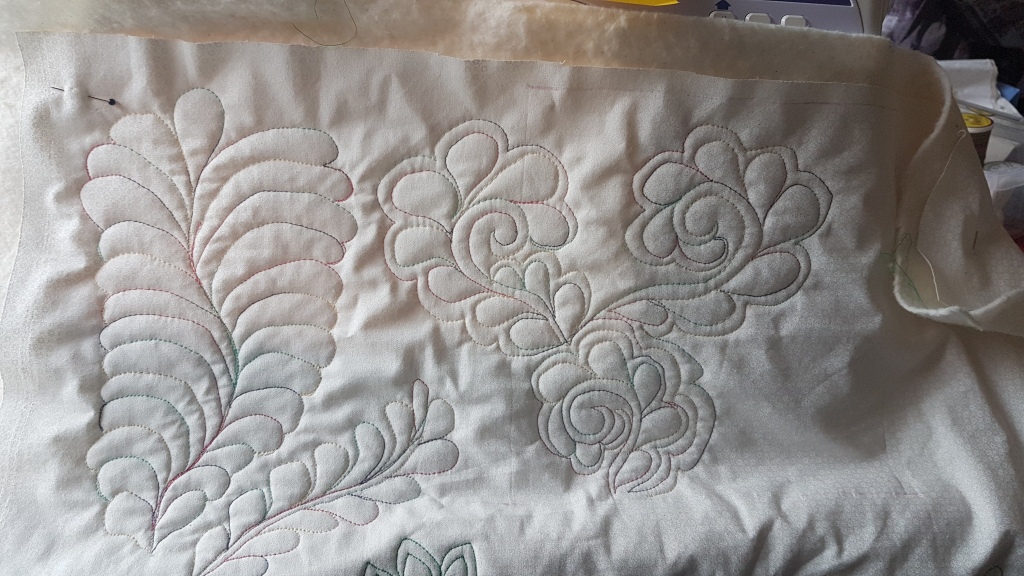
My friend (and past research colleague), Frances Bell, is attending an online free motion building quilting course run by The Crafty Nomad. I have been enjoying watching her progress as she posts images of her practise samples to her Flickr site, and rather envying her skills. Frances has already made some beautiful quilts so it was interesting to read her explanation of why she is doing this course:
What I am hoping to learn from this course is more about constructing a design – putting together different elements into an overall design. The project that I’ll do in a couple of weeks will have 12 coloured rectangles separated by white space so that’s plenty of opportunity for experimentation.
The image above was the first photo that I noticed. I really liked the trailing thread in the top left hand corner, which I saw as ‘breaking the boundary’, an idea that for some reason appealed to me. Frances explained ‘the stitching that breaks the boundary was where I started’, which of course made sense (you have to start somewhere), but I still prefer to think of it as breaking the boundary! Frances went on to explain that ,
… we are encouraged to have a high contrast between the thread and fabric colours. This is so that the “mistakes” stand out so we can work on avoiding them. Then in the projects we will choose a thread that blends with the fabric to make any mistakes recede. I think there’s a powerful message in there for learning/education in general. There’s a lot of controversy about “safe spaces” but I do like the idea of an educational space where learners are comfortable to acknowledge what they will do differently next time.
This idea of making mistakes stand out is further developed by Frances in another practise sample that I really like.

My reaction to this sample was: This is lovely. I like the different coloured stitching on the white background – very subtle and delicate, and once again Frances responded that this is a technique used to highlight errors:
I love variegated threads – they tend to distract from errors. I have chosen a different contrast thread for each module specifically to highlight errors while learning on practice pieces.
Quite by chance, at the same time as having this exchange with Frances I have come across the idea of ‘the imperfect stitch’, or ‘Persian flaw’, which is a deliberate error in an otherwise perfect work of art. The errors are not intended to detract from the beauty of the work of art (which could be a rug, a piece of embroidery, a quilt, or a piece of pottery), but rather to be subtly introduced (so subtly that the imperfection might be difficult to detect), to signify the inherent humanity and imperfection of the artist.
‘A Persian rug is perfectly imperfect, and precisely imprecise’.
In the eyes of the Persian rug makers and in other cultures of rug makers, such as the Navajo rug weavers, ‘Only God is perfect’. Flaws are an integral part of being human. Similarly, according to Iain McGilchrist, in Chinese architecture, the last three tiles are always left off the roof. The first great Chinese historian, Ssu-ma Ch’ien, records:
Even heaven is not complete; that is why when people are building a house they leave off the last three tiles, to correspond. And all things that are under the sky have degrees. It is precisely because creatures are incomplete that they are living .
(Ssu-ma Ch’ien’ quoted in The Matter With Things (TMWT) by Iain McGilchrist , p.840)
When I first came across the photos of Frances’ work which I like so much, I hadn’t read Iain McGilchrist’s chapter on The Coincidence of Opposites (Chapter 20) in his new book, The Matter With Things. Our Brains, Our Delusions, and the Unmaking of the World. In this chapter Iain writes about the importance of asymmetry. Here are a few quotes from the chapter:
‘There is also a necessity for slight imperfections in DNA transcription for there to be change and creativity: evolution.’ (p. 840, TMWT)
‘Sameness is indeed sterile, and cannot give rise to anything.’ (p. 840, TMWT)
‘Balance needs to be constantly disturbed and restored. Symmetry breaking is everywhere in living organisms.’ (p.840, TMWT)
I realise now that this is why I was drawn to Frances’ practise samples with their errors, which I find so attractive. They include an asymmetry which is a beautiful expression of the combination of sameness and difference, order and disorder (TMWT, p.839). For me, the art of deliberate imperfection seems one worth pursuing, and one which helps to ensure the uniqueness of the art. I wonder what Frances’ tutor would make of this idea, and indeed Frances herself?
References
Patowary, K. (2017). The Art of Deliberate Imperfection
Why Imperfect Quilts are Beautiful
Deliberate Mistakes in Handmade Persian Rugs and Carpets
McGilchrist, I. (2021). The Matter With Things. Our Brains, Our Delusions, and the Unmaking of the World. Perspectiva Press.
Mackness, J. (2021). The Coincidence of Opposites. A talk by Iain McGilchrist